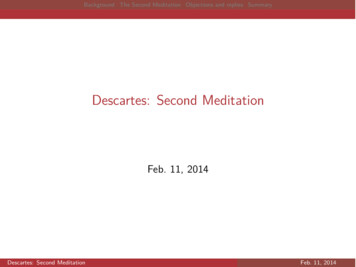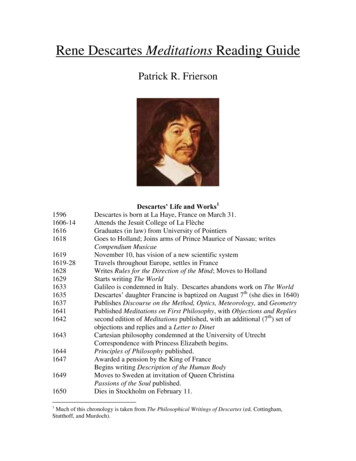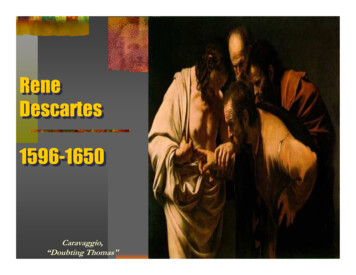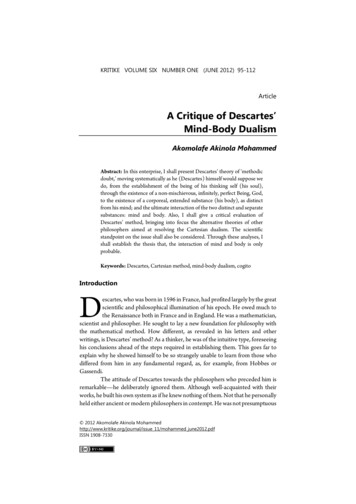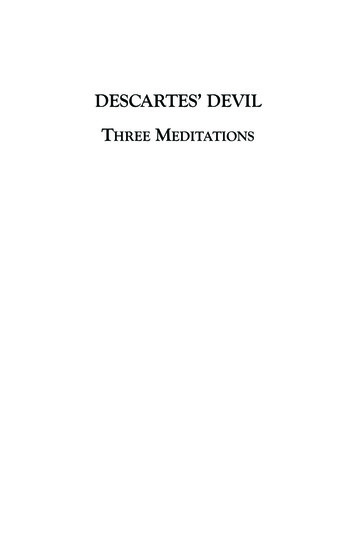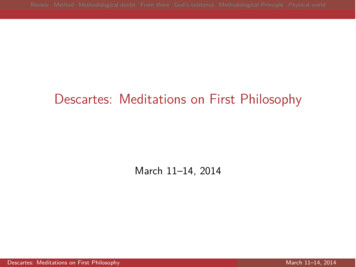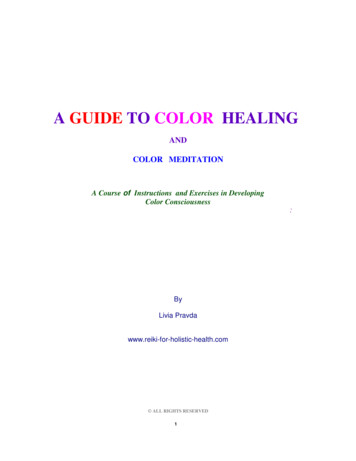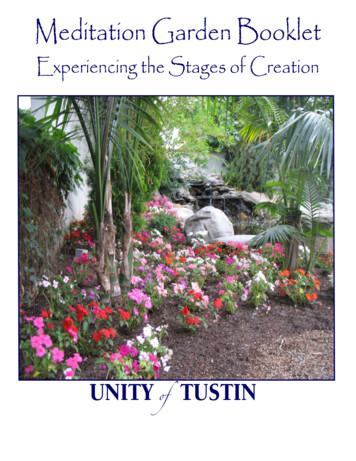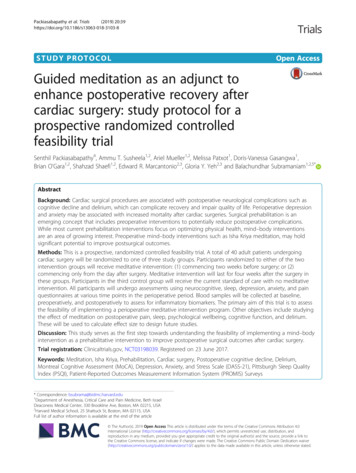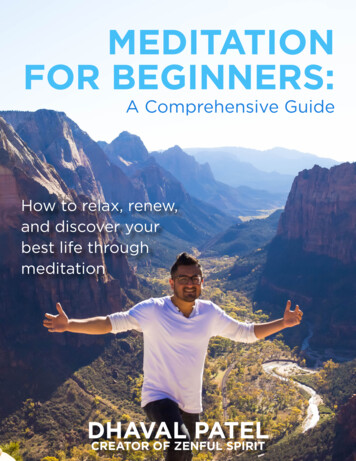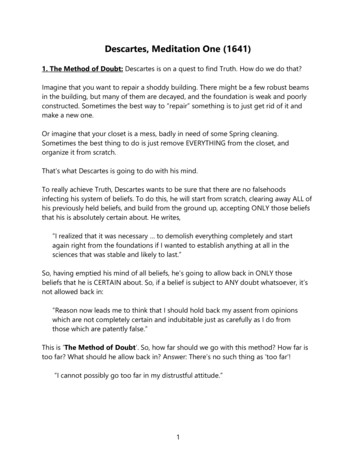
Transcription
Descartes, Meditation One (1641)1. The Method of Doubt: Descartes is on a quest to find Truth. How do we do that?Imagine that you want to repair a shoddy building. There might be a few robust beamsin the building, but many of them are decayed, and the foundation is weak and poorlyconstructed. Sometimes the best way to “repair” something is to just get rid of it andmake a new one.Or imagine that your closet is a mess, badly in need of some Spring cleaning.Sometimes the best thing to do is just remove EVERYTHING from the closet, andorganize it from scratch.That’s what Descartes is going to do with his mind.To really achieve Truth, Descartes wants to be sure that there are no falsehoodsinfecting his system of beliefs. To do this, he will start from scratch, clearing away ALL ofhis previously held beliefs, and build from the ground up, accepting ONLY those beliefsthat his is absolutely certain about. He writes,“I realized that it was necessary to demolish everything completely and startagain right from the foundations if I wanted to establish anything at all in thesciences that was stable and likely to last.”So, having emptied his mind of all beliefs, he’s going to allow back in ONLY thosebeliefs that he is CERTAIN about. So, if a belief is subject to ANY doubt whatsoever, it’snot allowed back in:“Reason now leads me to think that I should hold back my assent from opinionswhich are not completely certain and indubitable just as carefully as I do fromthose which are patently false.”This is ‘The Method of Doubt’. So, how far should we go with this method? How far istoo far? What should he allow back in? Answer: There’s no such thing as ‘too far’!“I cannot possibly go too far in my distrustful attitude.”1
2. Can I Trust My Senses? Most of our beliefs are formed based on what we perceivewith our senses. Can these be trusted? Surely not all of the time!Have you ever seen a mirage?To the right, it looks as if there iswater on the ground in thedistance, when there is not.Or, how about this glass of water(below)? When you immerse apencil or a stick in water, it looksbent or disconnected, eventhough it is perfectly straight.Now look at the lines below and ask: Which one is longer?The top line appears to be longer, but they are boththe same length. Don’t believe me? Go get a ruler!Now check out this album cover, and 2 gray squares:2
Does the pattern on the left appear to be breathing? It isn’t. It’s perfectly motionless.Do the two squares appear to be different colors? They’re not. They’re the same.Thus, the senses are not infallible. Therefore, they cannot be trusted.Reply: Okay, sure. You’ve made your point. Sometimes the senses do deceive us. But,surely lots of beliefs that come from the senses are impossible to doubt; e.g., that I amsitting here, typing up notes, that I have a body, and hands, etc. Surely, such things AREcertain. It would be madness to deny it!“how could it be denied that these hands or this whole body are mine? Unlessperhaps I were to liken myself to madmen, whose brains are so damaged by thepersistent vapours of melancholia that they firmly maintain they are kings when theyare paupers, or say they are dressed in purple when they are naked, or that theirheads are made of earthenware, or that they are pumpkins, or made of glass.”Reply: keep in mind that Descartes plans to withhold assent from any belief that is “notcompletely certain and indubitable”. This means that “anything which admits of theslightest doubt” will not be trusted. By admitting that the senses SOMETIMES deceiveus, we are admitting that they at the very least admit of the “slightest doubt”. Therefore,for the sake of this exercise, the senses in general cannot be trusted:“from time to time I have found that the senses deceive, and it is prudent never totrust completely those who have deceived us even once.”3. I Could Be Dreaming: But, Descartes gives us even more reason to doubt thesenses. Consider: In the past, I have dreamt that I am sitting, typing up notes, with abody, and hands, etc. And there is no way to be certain that you are not dreamingNOW. Therefore, NOTHING that our senses tell us is certain. For all I know, I am NOTsurrounded by desks and students—I might just be dreaming So, ALL of my sensesare ALWAYS doubtable!“Suppose then that I am dreaming Perhaps indeed, I do not even have suchhands or such a body at all.”For all I know, I don’t even have hands! (I might be a dreaming tentacle monster!)Reply: But, my present experiences are simply too VIVID to be a dream.3
Rebuttal: “But, this seems so real!” you say. But, that is exactly what a deceived personWOULD say, if the deception were vivid and realistic enough. Haven’t you ever had adream that was SO vivid that you mistook it for reality? You have to admit that it’s atleast POSSIBLE to have a dream that vivid.There is no way for you to be certain that you are not having that sort of dream rightNOW. Therefore, the things that the senses tell us are not absolutely, 100% certain.Reply: Let’s do an experiment: Right now, invent a totally new creature. Draw theweirdest, most creative, foreign, exotic creature you can possibly imagine—unlikeanything you’ve ever seen in as many respects as possible. What’s your creature like?Very likely, it has limbs, or tentacles, or eyes, or a mouth, or hair, or spots, or In short,it’s probably just a collection of things you HAVE seen on animals before. At the veryleast, you’ll have to admit this: It AT LEAST has extension, size, shape, quantity, place,and time; its color is not some “new” color that no one has ever seen before; and so on.Even if this IS a dream, dreams (like art) “must [be] fashioned in the likeness of thingsthat are real.” So, at the very least, things like colors, extension, shapes, sizes, quantities,numbers, and duration must be derived from things that exist SOMEWHERE in reality.And arithmetic and geometry are the study of these things. So, those domains of studystill deliver certain knowledge.“For whether I am awake or asleep, two and three added together are five, and asquare has no more than four sides. It seems impossible that such transparent truthsshould incur any suspicion of being false.”4. God Could Be Deceiving Me: Haven’t you ever seen someone make a math mistake?They were so certain they had the right answer, but they were wrong. It is at leastPOSSIBLE that things are like this every time we do math, or geometry. Descartes writes,“just as I consider that others sometimes go astray in cases where they think theyhave the most perfect knowledge, how do I know that God has not brought it aboutthat I too go wrong every time I add two and three or count the sides of a square ?”4
How could that be? Here’s one way: Isn’t it at least POSSIBLE that an omnipotent Godexists, and that God deceives me at every moment into thinking that 2 2 4, or thatsquares have four sides?Perhaps there aren’t even such THINGS as sizes, shapes, numbers, places, times, etc.Couldn’t an ALL-powerful God deceive me into thinking that those things exist, when infact they don’t? At the very least, we can’t be CERTAIN that this is the case—andremember that we’re casting out beliefs that are subject to even the TINIEST bit ofdoubt whatsoever.Reply: But, God is supposed to be good. A good God wouldn’t allow us to be deceived.Rebuttal: But, we ARE in fact deceived by our senses at least sometimes (noted above).So, surely, if God exists, then He (at least sometimes) allows us to be deceived.In any case, if the deceitful God example is unsatisfactory, make it an evil demon. A verypowerful, evil demon could deceive me into believing that I am living a real life, and thatI am a teacher who studies philosophy—but in reality my life is nothing like that at all,such that ALL that I presently believe to be true is actually false.5. Conclusion: Absolute Skepticism: Meditation One ends on a bleak note. We tookeverything out of our closet to do some Spring cleaning – and what did we find that wecould put back in? Answer: Nothing. Nothing at all.“I am finally compelled to admit that there is not one of my former beliefs aboutwhich a doubt may not properly be raised.”So, the tentative conclusion is one of absolute skepticism. We should be agnostic (i.e.,we should ‘withhold assent’) about anything that is subject to any doubt whatsoever(i.e., anything that is not completely certain). As it turns out, EVERYTHING is subject to atleast a little doubt. Therefore, we should not believe anything at all. Descartes sums up:“I shall think that the sky, the air, the earth, colors, shapes, sounds and all externalthings are merely the delusions of dreams I shall consider myself as not havinghands or eyes, or flesh, or blood or senses but as falsely believing that I have allthese things ; and, even if it is not in my power to know any truth, I shall at least dowhat is in my power, that is, resolutely guard against assenting to any falsehoods ”[What do you think? Has the mission to guard against falsehoods been taken a bit too far?Is it SO important to ensure that NOTHING you believe is false?]5
Descartes, Meditation Two (1641)Recap: The project: Descartes begins anew, reiterating his method of doubt. He states,“Anything which admits of the slightest doubt I will set aside just as if I had found itto be wholly false; and I will proceed in this way until I recognize something certain,or, if nothing else, until I at least recognize for certain that there is no certainty.”1. That ‘One Certain Thing’: Imagine that you are sitting on one side of a teeter-totter,and the biggest kid on the playground sits down on the other side. You are immediatelyshot up into the air with no way to get back down. How do you lift the biggest kid inschool? Well, Archimedes, the ancient Greek philosopher who studied the power oflevers and fulcrums noticed that, so long as the fulcrum (the middle of the teeter-totterthat rests on the ground) is firmly fixed, all we would need to do is make your side ofthe teeter-totter LONGER. And this is true, no matter how heavy the object on the otherside is. He then claimed that, if he could just find one single immovable point to serve asa fulcrum, he could place a lever upon it and move the entire Earth.Descartes says that he is metaphorically looking for something similarly fixed. If he couldjust find that one certain thing, he says, he could hoist ALL of our knowledge upon it.“Archimedes used to demand just one firm and immovable point in order to shift theentire earth; so I too can hope for great things if I manage to find just one thing,however slight, that is certain and unshakeable.”2. ‘I Exist’: The outlook at the end of Meditation One was grim. What did we discover?That NOTHING is certain? Wait! Could THAT be our “one certain thing”?“So what remains true? Perhaps just the one fact that nothing is certain.”Yet, are we even certain of THIS? For all we know, maybe there IS still something elseout there that is undoubtable—in which case the statement above is false.But, how can we possibly have overlooked anything? The lesson of Meditation One wasthat we don’t know anything about ANYTHING! I don’t know if sizes or shapes exist, or ifnumbers exist, or if my hands exist. For all I know, maybe *I* don’t even exist! Wait. Can that be right? (Think about that for a moment)6
A-ha! As soon as he doubts his own existence, Descartes realizes something: If his ownexistence is doubted, then SOMETHING must be doing the doubting. Thus, doubtingone’s own existence only PROVES one’s own existence!Puzzled? Consider it this way:Question: Is it doubtable that I exist? (a yes or no question)No: Then I DO exist.Yes: Then DOUBT OCCURS, and we’ll call the thing that is doubting ME.Either way, “I exist” must be true.If I try to doubt my existence, the very act of doubting affirms that something exists;namely, ME, the thing that doubts. To deny my own existence is self-defeating. ForSOMETHING must exist in order to do the denying. Therefore, I know for certain that ‘Iexist’ or ‘I AM’ is true.“So after considering everything very thoroughly, I must finally conclude that thisproposition, I am, I exist, is necessarily true whenever it is put forward by me orconceived in my mind.”You have probably heard Descartes’ famous saying: “I think, therefore I am.” He puts itthis way in his other works. For instance:And finally, considering the fact that all the same thoughts we have when we areawake can also come to us when we are asleep, without any of them being true, Iresolved to pretend that all the things that had ever entered my mind were no moretrue than the illusions of my dreams. But immediately afterward I noticed that, while Iwanted thus to think that everything was false, it necessarily had to be the case that I,who was thinking this, was something. And noticing that this truth—I think, thereforeI am—was so firm and so assured that all the most extravagant suppositions of theskeptics were incapable of shaking it. I judged that I could accept it without scrupleas the first principle of the philosophy I was seeking. (Discourse on Method, IV)While we thus reject everything we can possibly doubt, and feign that it is false, it iseasy to suppose that there is no God, no heaven, no bodies, and that we have nohands, no feet, indeed no body; but we cannot in the same way conceive that wewho doubt these things are not; for there is a contradiction in conceiving that whatthinks does not, at that same time as it thinks, exist. And hence this conclusionI think, therefore I am, is the first and most certain that occurs to one whophilosophizes in an orderly way. (Principles of Philosophy, 1.7)7
A historical note: Descartes has received much praise for saying this. But, this style ofproof actually dates to at least 1,250 years before Descartes’ Meditations. Consider thefollowing passages from 4th century theologian and philosopher, Augustine of Hippo:“I will first ask you whether you yourself exist. Or do you perhaps fear that youmight be mistaken even about that? Yet you could certainly not be mistakenunless you existed. Well then, it is obvious that you exist ” (On Free Choiceof the Will, 2.3, 391 AD)And, 35 years later, Augustine elaborates:“I am quite certain that I am, that I know that I am, and that I love this being andthis knowing. I need not quail before the Academicians when they say: ‘What ifyou should be mistaken?’ Well, if I am mistaken, I exist. For a man who does notexist can surely not be mistaken either, and if I am mistaken, therefore I exist. So,since I exist if I am mistaken, how can I be mistaken in believing that I exist whenit is certain that if I am mistaken, I exist. Therefore, from the fact that, if I wereindeed mistaken, I should have to exist to be mistaken, it follows that I amundoubtedly not mistaken in knowing that I exist.” (City of God, 11.26; 426 AD)3. All Thinking Is Certain: So far we have said that the entire material world is NOTcertain, and that your own existence IS certain. But, what of your inner, MENTAL world?Could I be deceived into thinking that I am having thoughts, when in fact I am nothaving thoughts at all? Answer: No! That is impossible. Consider:Take pain for instance. Imagine you are in a hospital bed, suffering excruciating pain:“I am in pain,” you say to the doctor.“No you’re not,” she says. “You’re deceived about that. You’re not really in pain at all!”Does that make ANY sense? NO! There is NO WAY that you can be mistaken about this.If you FEEL that you are in pain, then you ARE in pain—and no one can take this factaway from you. All that is doubtable is the SOURCE of that pain; e.g., you continue,“No. I am in pain. My leg is killing me!” Doctor pulls back cover to reveal a bandaged stump. “But, that’s impossible!” she says. “I amputated your leg an hour ago.”Perhaps the CAUSE of the pain is doubtable. But, the PAIN SENSATION is not. If you arehaving an experience of pain, then you are having an experience of pain. End of story.8
A similar story can be told about ALL of your inner, mental life, including doubting,understanding, affirming, denying, willing, unwilling, imagining, and sensing. Perhapsyou are not absolutely certain that you have hands, but you CAN be certain that youSEEM to have hands—i.e., regardless of whether you ACTUALLY have hands, you’recertainly having a SENSATION of hands.“I am now seeing light, hearing a noise, feeling heat. But [suppose] I am asleep, so allthis is false. Yet I certainly seem to see, to hear, and to be warmed. This cannot befalse.”What am I? We have established that THINKING is undoubtable. Well, ‘I’ am just thethinking thing (whatever it is that’s doing the thinking, and having the sensations).Furthermore, each and every one of my thoughts affirms MY existence. Every timethought occurs, I am certain that thinking is, and therefore I AM.[Side note: Descartes takes this to be proof for ‘substance dualism’. If you CANNOT becertain of the existence of any material body, but you CAN be certain of your ownexistence (i.e., the existence of your self), then it must be the case that your ‘self’ is not amaterial body. Rather, it must be something immaterial. A ‘soul’. Whoa ]4. The Wax: In short, we’re MUCH more certain of the mental, which might not even bematerial (Descartes thinks it’s conclusively IM-material) than we are of material objects.Objection: But, that’s counter-intuitive! Surely I am MUCH more acquainted with thingslike tables and trees and hands than I am of this weird ephemeral ‘thinking thing’!Reply: Oh, so you think you understand what material objects are, do you? Consider:The Example of the Wax Descartes examines a piece of wax, taken from ahoneycomb. It tastes like honey, it smells like flowers; it has color, shape, size; it ishard, cold, and it makes a sound when he strikes it. But, he puts it near the fire,and the taste and smell go away. The color, shape, and size change; the waxbecomes soft, hot, and no longer makes a sound when he strikes it.Every perceivable property that the wax formerly had went away when heat was applied.Yet, remarkably, everyone will agree that it is still the same wax! So, what, exactly, IS thisthing that remained throughout all of these changes? Describe it.The wax isn’t any of its described properties. For it LOST all of those! It must bewhatever is “underneath” all of those. To get at the WAX itself, we must9
“distinguish the wax from its outward forms—take the clothes off, as it were, andconsider it naked ”Whoa, kinky! But, what in the heck are we talking about!? We may THINK weunderstand what matter is, but this illustration demonstrates that we really have no ideawhat the underlying thing that possesses properties is. We do not, in fact, ever evenPERCEIVE material objects! Rather, material bodies are something we JUDGE to existwith the mind.“I now know that even bodies are not strictly perceived by the senses or the faculty ofimagination but by the intellect alone ; and in view of this I know plainly that I canachieve an easier and more evident perception of my own mind than of anything else.”Uh-oh! We NEVER perceive material bodies directly? As we’ll soon discover, this isgoing to cause some trouble. (the veil of perception) Consider also:“if I look out of the window and see men crossing the square, as I just happen tohave done, I normally say that I see the men themselves, just as I say that I see thewax. Yet do I see any more than hats and coats which could conceal automatons? Ijudge that they are men. And so something which I thought I was seeing with myeyes is in fact grasped solely by the faculty of judgment which is in my mind.”Uh-oh! We NEVER perceive other people? (We only judge them to exist.) As we’ll seelater, this is going to cause trouble too. (the problem of other minds / solipsism)Conclusion: Mind More Distinct Than Matter: In any case, Descartes concludes that,while it may SEEM that you understand the nature of things like tables more than minds,you’re wrong. For, you never really see material things. You merely JUDGE them to existbased on sensations and appearances. But, sensation and judgement (of, say, a table)actually confirm the existence of your MIND more than the existence of a TABLE! For, asmental actions (i.e., THOUGHTS), they affirm with certainty that a thinking thing exists.5. Re-Building All Knowledge Upon This Foundation: So, Descartes has found his“one certain thing”—his Archimedean point—upon which he will hoist all knowledge.How does he do this? Long story short, from the things he is certain about (his ownexistence, and his own mental world of sensations and thoughts and ideas) he goes onto prove the existence of God. And, from there it follows that we CAN trust our sensesfor the most part, since a good God would not allow us to be constantly deceived. Voila!(Watch some fun videos here and here and here)10
Descartes, Meditation One (1641) 1. The Method of Doubt: Descartes is on a quest to find Truth. How do we do that? Imagine that you want to repair a shoddy building. There might be a few robust beams in the building, but many of them are de
